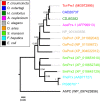Characterisation of a niche-specific excretory-secretory peroxiredoxin from the parasitic nematode Teladorsagia circumcincta
- PMID: 31292008
- PMCID: PMC6617597
- DOI: 10.1186/s13071-019-3593-6
Characterisation of a niche-specific excretory-secretory peroxiredoxin from the parasitic nematode Teladorsagia circumcincta
Abstract
Background: The primary cause of parasitic gastroenteritis in small ruminants in temperate regions is the brown stomach worm, Teladorsagia circumcincta. Host immunity to this parasite is slow to develop, consistent with the ability of T. circumcincta to suppress the host immune response. Previous studies have shown that infective fourth-stage T. circumcincta larvae produce excretory-secretory products that are able to modulate the host immune response. The objective of this study was to identify immune modulatory excretory-secretory proteins from populations of fourth-stage T. circumcincta larvae present in two different host-niches: those associated with the gastric glands (mucosal-dwelling larvae) and those either loosely associated with the mucosa or free-living in the lumen (lumen-dwelling larvae).
Results: In this study excretory-secretory proteins from mucosal-dwelling and lumen-dwelling T. circumcincta fourth stage larvae were analysed using comparative 2-dimensional gel electrophoresis. A total of 17 proteins were identified as differentially expressed, with 14 proteins unique to, or enriched in, the excretory-secretory proteins of mucosal-dwelling larvae. One of the identified proteins, unique to mucosal-dwelling larvae, was a putative peroxiredoxin (T. circumcincta peroxiredoxin 1, Tci-Prx1). Peroxiredoxin orthologs from the trematode parasites Schistosoma mansoni and Fasciola hepatica have previously been shown to alternatively activate macrophages and play a key role in promoting parasite induced Th2 type immunity. Here we demonstrate that Tci-Prx1 is expressed in all infective T. circumcincta life-stages and, when produced as a recombinant protein, has peroxidase activity, whereby hydrogen peroxide (H2O2) is reduced and detoxified. Furthermore, we use an in vitro macrophage stimulation assay to demonstrate that, unlike peroxiredoxins from trematode parasites Schistosoma mansoni and Fasciola hepatica, Tci-Prx1 is unable to alternatively activate murine macrophage cells.
Conclusions: In this study, we identified differences in the excretory-secretory proteome of mucosal-dwelling and lumen-dwelling infective fourth-stage T. circumcincta larvae, and demonstrated the utility of this comparative proteomic approach to identify excretory-secretory proteins of potential importance for parasite survival and/or host immune modulation.
Keywords: Anti-oxidant; Excretory–secretory; Niche; Peroxidase; Peroxiredoxin.
Conflict of interest statement
The authors declare that they have no competing interests.
Figures






Similar articles
-
A preliminary proteomic characterisation of extracellular vesicles released by the ovine parasitic nematode, Teladorsagia circumcincta.Vet Parasitol. 2016 May 15;221:84-92. doi: 10.1016/j.vetpar.2016.03.008. Epub 2016 Mar 17. Vet Parasitol. 2016. PMID: 27084478 Free PMC article.
-
Teladorsagia circumcincta: activation-associated secreted proteins in excretory/secretory products of fourth stage larvae are targets of early IgA responses in infected sheep.Exp Parasitol. 2010 Aug;125(4):329-37. doi: 10.1016/j.exppara.2010.02.014. Epub 2010 Mar 3. Exp Parasitol. 2010. PMID: 20206168
-
Niche-specific gene expression in a parasitic nematode; increased expression of immunomodulators in Teladorsagia circumcincta larvae derived from host mucosa.Sci Rep. 2017 Aug 3;7(1):7214. doi: 10.1038/s41598-017-07092-0. Sci Rep. 2017. PMID: 28775251 Free PMC article.
-
Genetic variation in resistance to mixed, predominantly Teladorsagia circumcincta nematode infections of sheep: from heritabilities to gene identification.Parasite Immunol. 2009 May;31(5):274-82. doi: 10.1111/j.1365-3024.2009.01105.x. Parasite Immunol. 2009. PMID: 19388948 Review.
-
Teladorsagia circumcincta in the sheep abomasum: defining the role of dendritic cells in T cell regulation and protective immunity.Parasite Immunol. 2009 Jul;31(7):347-56. doi: 10.1111/j.1365-3024.2009.01110.x. Parasite Immunol. 2009. PMID: 19527450 Review.
Cited by
-
Prospects of Using High-Throughput Proteomics to Underpin the Discovery of Animal Host-Nematode Interactions.Pathogens. 2021 Jun 30;10(7):825. doi: 10.3390/pathogens10070825. Pathogens. 2021. PMID: 34209223 Free PMC article. Review.
-
Hookworm genes encoding intestinal excreted-secreted proteins are transcriptionally upregulated in response to the host's immune system.bioRxiv [Preprint]. 2025 Feb 3:2025.02.01.636063. doi: 10.1101/2025.02.01.636063. bioRxiv. 2025. PMID: 39975173 Free PMC article. Preprint.
-
A Complex Proteomic Response of the Parasitic Nematode Anisakis simplex s.s. to Escherichia coliLipopolysaccharide.Mol Cell Proteomics. 2021;20:100166. doi: 10.1016/j.mcpro.2021.100166. Epub 2021 Oct 19. Mol Cell Proteomics. 2021. PMID: 34673282 Free PMC article.
-
The Functional Parasitic Worm Secretome: Mapping the Place of Onchocerca volvulus Excretory Secretory Products.Pathogens. 2020 Nov 23;9(11):975. doi: 10.3390/pathogens9110975. Pathogens. 2020. PMID: 33238479 Free PMC article. Review.
-
Endogenous Fluorescent Proteins in the Mucus of an Intertidal Polychaeta: Clues for Biotechnology.Mar Drugs. 2022 Mar 25;20(4):224. doi: 10.3390/md20040224. Mar Drugs. 2022. PMID: 35447897 Free PMC article.
References
-
- Sommerville RI. The histotropic phase of the nematode parasite, Ostertagia circumcincta. Aust J Agric Res. 1954;5:130–140. doi: 10.1071/AR9540130. - DOI
-
- McNeilly TN, Frew D, Burgess STG, Wright H, Bartley DJ, Bartley Y, et al. Niche-specific gene expression in a parasitic nematode; increased expression of immunomodulators in Teladorsagia circumcincta larvae derived from host mucosa. Sci Rep. 2017;7:7214. doi: 10.1038/s41598-017-07092-0. - DOI - PMC - PubMed
MeSH terms
Substances
Grants and funding
LinkOut - more resources
Full Text Sources

